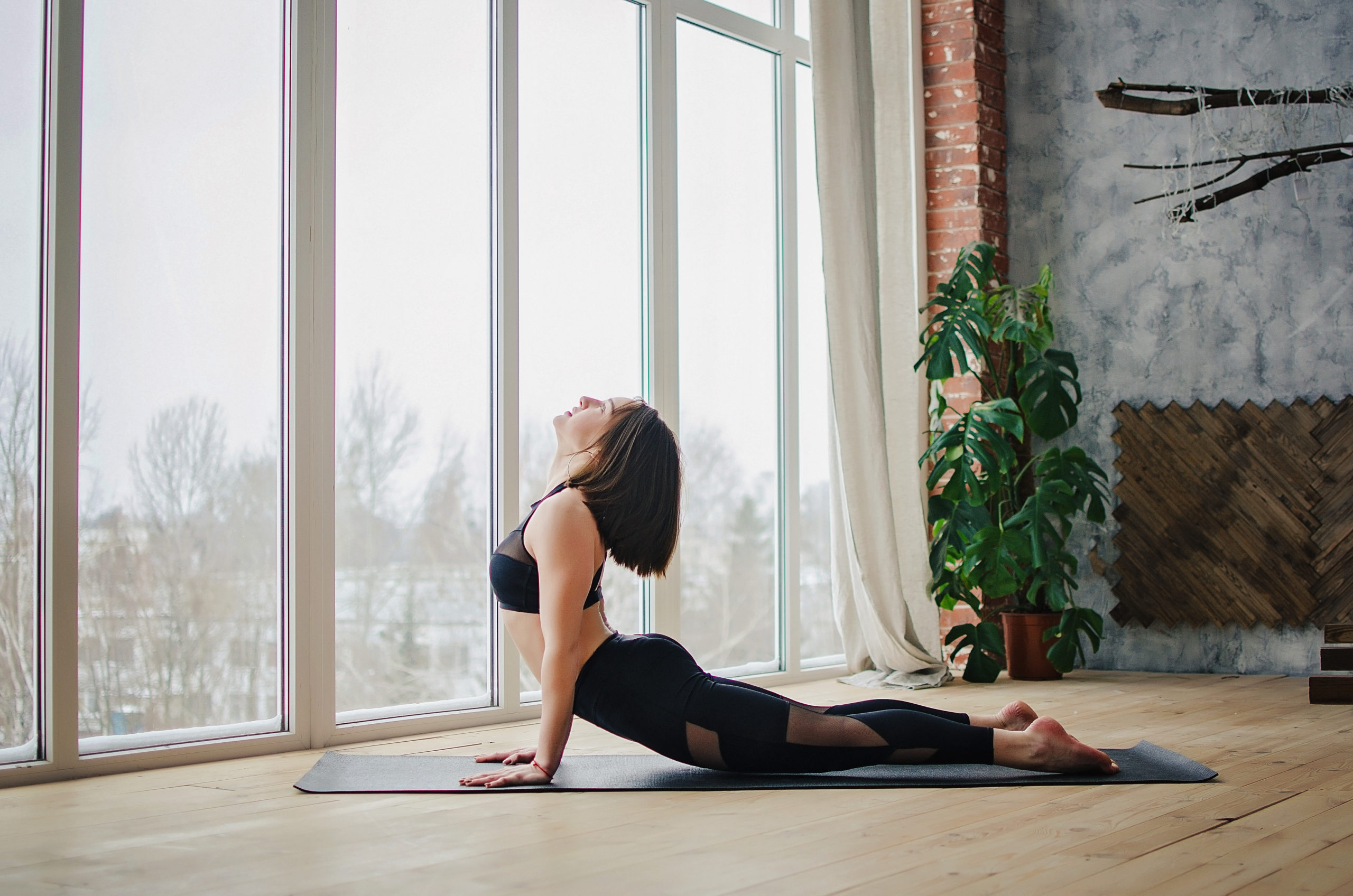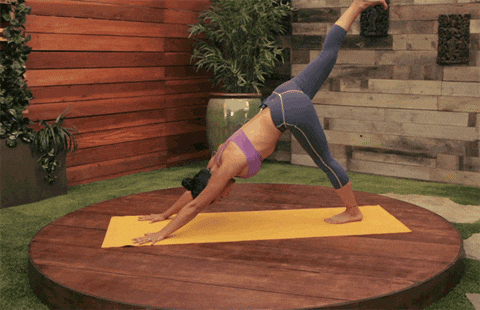Wellness
11 Simple At-Home Yoga Exercises For A Healthy Mind And Body!
Hope all of you guys are locked and safe at home! We know it can get pretty boring staring at...
By: Beauty Insider Journalist / April 1, 2020

Hope all of you guys are locked and safe at home! We know it can get pretty boring staring at the wall all day hence here is a great way to spend your time productively. Try out some at-home yoga exercises. Yeap, that’s right, YOGA! Wait, wait, wait- we can hear you screaming my body isn’t flexible enough for yoga!!
But before you give up, let us assure you yoga isn’t exactly as hard as they look! In fact, all you need is a good mat, some space and strong will power. If you think you’ve got these, then c’mon and let’s do these simple at-home yoga exercises now!
Contents
- What is Yoga?
- What Are The Benefits of At-Home Yoga Exercises?
- What Are The Easiest At-Home Yoga Exercises To Try?
- 1. Downward-Facing Dog (Adho mukha svanasana)
- 2. Cow Face Pose (Gomukhasana)
- 3. Cat-Cow Stretch (Chakravakasana)
- 4. Warrior Pose (Virabhadrasana)
- 5. Child’s Pose (Balasana)
- 6. Plank Pose (Kumbhakasana)
- 7. Upward-Facing Dog (Urdhva Mukha Svanasana)
- 8. Butterfly Pose (Baddha Konasana)
- 9. Mountain Pose (Tadasana)
- 10. Tree Pose (Vrksasana)
- 11. Side plank (Vasisthasana)
What is Yoga?

New to yoga? Well, don’t worry we got you covered on the details you need to know about yoga before jumping into the whole at-home yoga routine! The word yoga is derived from the Sanskrit word ‘Yuj’. In direct translation it Yuj means to yoke or bind and often is interpreted as “union” or a method of discipline. It is believed that the practice of yoga dates back to somewhat 2,000 years ago!
The Indian sage Patanjali has collated the practice of yoga into the Yoga Sutra, an ancient scripture that has a collection of 195 statements that serves as a philosophical guidebook for most of the yoga that is practised today. It also outlines eight limbs of yoga:
- Yamas (restraints),
- Niyamas (observances),
- Asana (postures),
- Pranayama (breathing),
- Pratyahara (withdrawal of senses),
- Dharana (concentration),
- Dhyani (meditation), and
- Samadhi (absorption).
As we explore these eight limbs, we begin by refining our behaviour in the outer world, and then we focus inwardly until we reach samadhi (liberation, enlightenment). Today, most people practising yoga are engaged in the third limb, asana. Asanas are a bunch of physical postures that are designed to purify the body and provide the physical and mental strength and stamina required for long periods of meditation.
What Are The Benefits of At-Home Yoga Exercises?

Practising yoga every day will bring many benefits for both your mental and physical health. In general, the purpose of yoga is to build strength, awareness and harmony in both the mind and body. Some of the major physical benefits yoga brings for you is that it can lessen chronic pain, such as lower back pain, arthritis, headaches and carpal tunnel syndrome. Regular practise can also lower blood pressure and reduce insomnia.
Other physical benefits of yoga include:
- Increased flexibility
- Increased muscle strength and tone
- Improved respiration, energy and vitality
- A balanced metabolism
- Weight reduction
Apart from the physical benefits, yoga also hosts a number of mental health benefits. One of the major benefits of doing at-home yoga exercises is that it can help you manage stress. This is because yoga incorporates meditation and breathing activities that can help improve a person’s mental well-being. Plus, yoga is also very effective in helping you develop coping skills and reaching a more positive outlook on life. Practise yoga regularly and you can feel more clarity and calmness within you.
What Are The Easiest At-Home Yoga Exercises To Try?

Because there are so many different kinds of yoga practices, it is possible for anyone to start. Whether you’re a couch potato or a professional athlete, there are so many yoga moves and poses for everyone. But remember, the idea is to explore your limits, not strive for some pretzel-like perfection. Start off slow, you’ll gradually improve with your body and your inner self. So, with further ado, below we present 11 simple at-home yoga exercises you should try!
1. Downward-Facing Dog (Adho mukha svanasana)
One of the most popular and easiest yoga poses, Downward-Facing Dog is a standing pose. It is a great pose that builds strength while stretching the whole body. In fact, the pose got its name after the way dogs naturally stretch their entire bodies! This pose is often used in yoga as a transitional pose and a resting pose.
How to Do:
- Spread your legs and bend downwards without bending your knees.
- Make sure to tuck your toes and lift your hips up and back to lengthen your spine.
- If your hamstrings feel a little tight, then keep your knees slightly bent in order to bring your weight back into the legs.
2. Cow Face Pose (Gomukhasana)
This is a seated yoga posture that deeply stretches the hips and shoulders. Plus it can also help calm the mind and bring balance to the whole body.
How to Do:
- Begin by seating with your legs extended in front of you and your arms resting at your sides.
- Then bend your knees, placing the soles of your feet flat on the floor.
- Then, bring your left foot underneath your right knee and slide it to the outside of your right hip.
- Your right knee should be directly on top of the left, and then slide your right foot to the outside of your left hip.
- Shift your weight slightly from side to side until you are sitting evenly on both sit bones.
- Extend your left arm up toward the ceiling with your palm facing forward. Then, bend your left elbow and bring your left hand to your spine.
- Hold the pose for up to one minute. Then, gently release your arms and uncross your legs. Then, repeat the pose on the opposite side for the same length of time.
3. Cat-Cow Stretch (Chakravakasana)
The Cat-Cow Stretch is indeed a yoga essential and for good reason. It involves moving the spine from a rounded position (flexion) to an arched one (extension). Each movement is done in conjunction with either an inhalation or exhalation of the breath. Avoid doing Cat-Cow pose if you have back pain!!!
How to Do:
- Get on your knees with your palm placed directly under your shoulder.
- Then, extend your spine and stretch as much as you could.
- You can repeat this a couple of times as moving back and forth awakens and warms the back.
4. Warrior Pose (Virabhadrasana)
This is a standing yoga pose named after the mythological Hindu warrior, Virabhadra (an incarnation of the god Shiva). This pose is great as it helps stretch the whole front side of the body and also the thighs, ankles, and back. Furthermore, this pose can improve your breathing capacity and invigorating the body. Apart from that, this pose can also make your mind become focused, calm, and clear.
How to Do:
- Stand with feet wide like 3–4 feet apart.
- Shift your right heel out so your toes are pointing slightly inward.
- Then, turn your left foot out 90 degrees.
- Line up your left heel with the arch of your right foot to draw your shoulder blades down the back, rotate your palms face-up.
- Notice how that shifts your shoulders. Once settled, rotate your palms face down.
5. Child’s Pose (Balasana)
Balasana is often used as a resting position in between more difficult poses during a yoga practice. The pose focuses on centring your mind hence it is very calming, soothing, and therapeutic for relieving stress. It can also help to stretch the hips, thighs, and ankles while gently relaxing the muscles. If you suffer from back and neck pain, this pose can help you relieve it.
How to Do:
- Start off by kneeling on the floor. Make sure your big toes are touching together and be seated on your heels. Then separate your knees about as wide as your hips.
- Exhale and lay your torso down between your thighs.
- Lengthen your tailbone away from the back of the pelvis while you lift the base of your skull away from the back of your neck.
- Lay your hands on the floor alongside your torso, palms up, and release the fronts of your shoulders toward the floor.
- Stay in a position anywhere from 30 seconds to a few minutes.
6. Plank Pose (Kumbhakasana)
Plank is most probably the best at-home yoga exercise that tones the abdominal muscles while strengthening the chest and low back. Adding on, the plank can also strengthen the muscles surrounding the spine, which improves your posture. Just by holding planks for several minutes every day, your body will have more endurance and stamina.
How to Do:
- Lie flat on your mat with your stomach. Place your hands under the shoulder.
- Then, draw your navel in toward your spine and keep your hips from dropping and lift yourself up!
- Try holding a plank for at least 30 seconds every day. As you get better then you can hold up longer.
7. Upward-Facing Dog (Urdhva Mukha Svanasana)
This pose is slightly hard to do but you can (we know you can!) It’s a great exercise that can improve your overall posture and strengthen the spine, arms and even the wrists. It is also great for the chest and lungs, shoulders, and abdomen! Plus, the pose can also firm your buttocks!!!
How to Do:
- First, lie facing downwards on the floor.
- Bend elbows and place hands on the mat in line with lower ribs.
- Hug your elbows in line with your torso.
- Tuck your toes and take an inhale.
- Push your body upwards and make sure your arms are straightened and the chest broadens.
8. Butterfly Pose (Baddha Konasana)
The Butterfly Pose is a wonderful grounding position that leads to the creation of a serene place for delving into a meditation state. The pose involves deep, relaxed breaths coordinated with the leg movements. It is also a great pose that will give a nice stretch to the spine after a long night sleep.
How to Do:
- Start the pose by sitting on the floor. Legs, back straight, and hands-on the ground.
- With an exhalation, bend the knees and bring the heels close to the pelvic region.
- Drop the knees out to the floor and touch the soles of the feet together.
- Clasp the hands around the ankles, shins, or toes.
- Stay in this pose for around 1-2 minutes.
9. Mountain Pose (Tadasana)
Simple yet effective, this is the most basic move in yoga and the best way to start your yoga at home journey. Though it may seem like you are just standing there, the Mountain Pose is an active pose that helps improve posture, balance, and calm focus.
How to Do:
- All you gotta do is stand with your feet together and hip-width apart.
- Then fold your feet in tight. After that, draw your shoulder blades and lift the crown of your head up.
10. Tree Pose (Vrksasana)
The Tree Pose is an excellent pose to improve your stability and concentration. It can also stretch your thighs, groins, torso, and shoulders. Moreover, it also builds strength in the ankles and calves, and tones the abdominal muscles.
How to Do:
- To do the tree pose you have to first start in mountain pose.
- Then find a fixed point in front of you and stare at it to help you balance.
- Slowly, shift the weight into your left foot and lift your right foot and fold it into your shin or inner thigh.
- You may struggle with balance issues at first but try and push yourself to hold the position for at least 10 seconds!
- You can take it a step further and lift your hands up toward the sky in a V-shape.
11. Side plank (Vasisthasana)
Side planks are hard but they are doable! Just like planks, side planks can strengthen your wrists, forearms, shoulders, and spine. Plus, they can also increase flexibility and balance. The best part is side planks can tone your tummy.
How to Do:
- First, start off with a normal plank position.
- Then, turn onto the outer edge of your right foot. Make sure that your right foot and right hand are in alignment.
- Then, stack your left foot on top of your right and support your weight using your left hand!
- Once you are stable, lift yourself up and try to lift your left hand up toward the sky.
- Hold the position for at least 30 seconds. Balance yourself by pressing the floor away from you with the bottom hand.
















